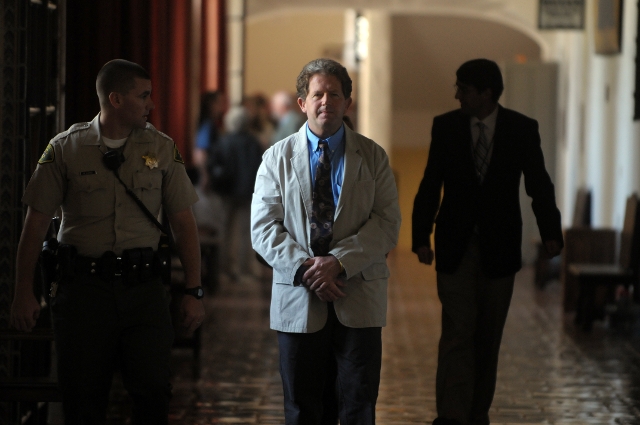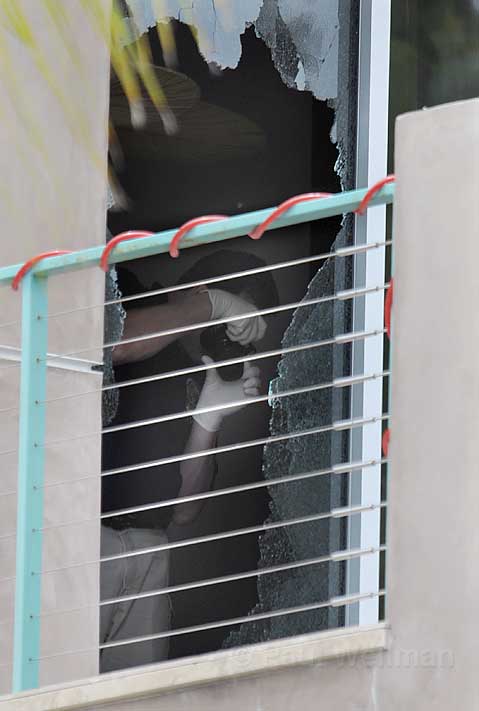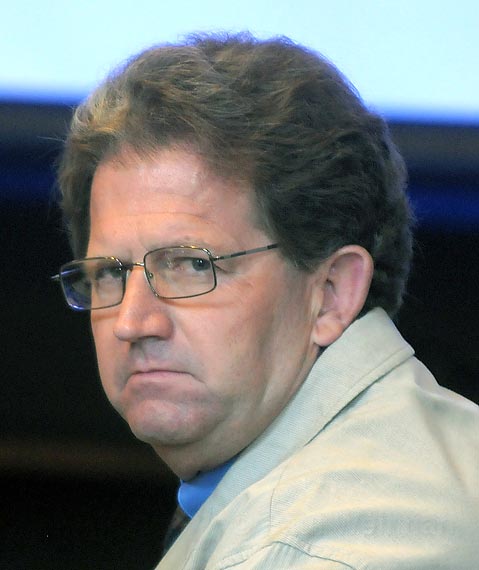Lyons Case Turns to Forensics
Crime Scene Investigator Talks Bullet Trajectory and Blood Spatter

Testimony given in the continuing trial of Corey Lyons — accused of shooting his brother and his brother’s partner to death in their Mesa home — revealed on Thursday that three guns were used in the brutal double homicide, strengthening defense attorney Robert Sanger’s argument that two unidentified people, and not his client, are responsible for the murders.
Crime scene photos taken inside both bedrooms where Dan Lyons and Barbara Scharton were killed also show that — when the victims were struck by shotgun shells and handgun slugs — their blood and tissue flew toward where the prosecution says Lyons was standing, a phenomenon crime scene investigator Mike Ullemeyer said is extremely rare but not out of the question.
Ullemeyer’s testimony picked up Thursday afternoon with him walking jurors through photographs taken in the upstairs and downstairs bedrooms. Earlier in the day the court was subjected to highly graphic images of both decedents, severely disfigured by multiple bullet wounds.

At the request of prosecuting attorney Gordon Auchincloss, Ullemeyer pointed out areas on the wall in the master bedroom — where Dan Lyons was killed — that were damaged by shotgun blasts, noting the impact craters were behind where Dan Lyons would have been standing. Shotgun pellets struck the center post of a sliding glass door, its frame, as well as its curtain, Ullemeyer said, and blew out the glass of the door itself. He also noted that the doorway’s center post had what appeared to be a blood smear on it.
Shifting to an examination of the far right corner of the bedroom, Ullemeyer indicated with his laser pointer on the projected photograph where he recovered a plastic wad, of the sort released from shotgun shells when they are fired and used to separate the pellets from the charge. The wadding, he said, was mixed in “with a high concentration of tissue and blood,” and was one of four wads discovered in that bedroom.
Auchincloss then began questioning Ullemeyer about a bullet hole discovered in a drawer built into the bedroom’s right-hand wall. (For clarity, this article refers to the wall where the glass door was located as the far wall. It is directly opposite the bedroom’s doorway, which is located in what will be referred to as the near wall. The right and left walls describe the direction of the room from the vantage point of a person standing in the doorway of the near wall, facing the far wall.)
The bottom drawer — below the damaged drawer — was removed to reveal a .38 caliber lead slug, explained Ullemeyer. A yellow, metal probe was inserted into the bullet hole itself, he went on, to determine the trajectory in which the bullet was travelling when it impacted. Ullemeyer said, based on the angle of the probe, it looked as if the bullet was moving in a downward trajectory. Another slug was found in a different drawer, its impact crater displaying a similar trajectory, and another bullet lodged itself in the sliding door’s left-hand frame.
In total, testified Ullemeyer, it appeared five .38 rounds and four shotgun rounds were fired in the upstairs bedroom. He spoke to the jury about a composite image he had created of the crime scene — explaining he stitched together multiple photos taken from the same vantage point since he didn’t have a wide enough lens to capture to the entire room in one shot — indicating with color- and symbol-coded lines where the nine shots landed, and which found their marks.

Ullemeyer also testified he believes the shots were fired exclusively from the near right corner of the room, near the doorway. Sanger would contest this theory later in the hearing during his cross-examination.
In what will likely be an intense area of focus throughout the rest of the trial, Auchincloss then asked Ullemeyer to point out blood spatter found — in addition to areas and surfaces on the far side of the room — on the left side of the bedroom’s doorway wall. Ullemeyer also testified that a small amount of blood was found near the doorway on the carpet.
Auchincloss asked the crime scene investigator if, to his knowledge, it’s possible for blood from a victim to fly back toward a shooter when the person is shot. This is in contrast to blood spatter typically found at a crime scene that moves behind the victim away from the shooter. Ullemeyer said it’s a highly unusual thing to happen, but “not impossible.”
Shifting to the forensic evidence found in the downstairs bedroom where Scharton was killed, Ullemeyer testified that blood was not only found on the room’s far wall, on the right wall above the bed, and on the ceiling, but also on the doorway wall. What looked like a piece of tooth or bone (what Ullemeyer cryptically described as “a piece of a human being”) was also found on the ground between Scharton and the entryway. Ullemeyer had posited that the shots that killed Scharton — which came from both a shotgun and a .22 caliber firearm — were fired exclusively from the area of the doorway.
(Again, for clarification purposes, the far wall is indicated as the wall opposite the room’s doorway, which is in the near wall. The right and left walls describe the direction of the room from the vantage point of a person standing in the doorway of the near wall, facing the far wall.)
Ullemeyer then shifted to describing to the jury how and why he processed the home’s downstairs back door for fingerprints. All of the other doors and windows were locked from the inside, he explained, meaning the downstairs patio door was most likely the entrance used by the suspect or suspects. There was no indication fingerprints would have been found elsewhere, Ullemeyer said, so he didn’t process any areas other than the door, its handle, and the rod — then removed — used to keep it from sliding open all the way. To fingerprint the entire house would have been “time prohibitive,” Ullemeyer explained.
Ullemeyer said he didn’t find any prints whatsoever on or near the door, nor did he discover any trace evidence — used to describe hard-to-see and/or unusual fibers or hairs — on the bodies or anywhere else in the residence.

During his opportunity for cross-examination, defense attorney Robert Sanger appeared to take issue with Ullemeyer and his team’s investigation. He started by questioning why Ullemeyer didn’t process more surfaces inside the Mesa home for fingerprints, criticizing the thoroughness of the investigator’s work. Ullemeyer countered that to “dust” every conceivable surface is a near-impossible task and an unwise use of any crime scene worker’s time. He said he and his team approached this investigation as they would any other and that he considered their efforts up to par.
The bulk of Sanger’s cross-examination kept up this line of questioning as the attorney attempted to call into question the reliability of Ullemeyer’s analysis at the scene and therefore his testimony in the courtroom. Sanger brought up the fact that Santa Barbara Police Department’s crime lab is essentially a windowless, 20-foot by 25-foot closet, and that members of California’s Department of Justice (DOJ) crime lab — located in Goleta — are oftentimes called in to assist with scene investigation. In this case, three members of the DOJ worked the Mesa home alongside Ullemeyer.
Sanger asked Ullemeyer how many detectives and officers tromped about the home before, after, and during the investigators’ examination of the scene. Ullemeyer said he didn’t know. Sanger also pointed out that Ullemeyer failed to indicate how often he changed his gloves — the investigator would claim he changed them every time he moved to a different room — and that his team didn’t wear any kind of protective clothing, like booties, body suits, or hair nets, to prevent the scene from becoming contaminated.
The defense attorney also highlighted how Ullemeyer didn’t use a magnifying glass or microscope to look for trace evidence, nor did he process a set of keys or wine glass found downstairs for fingerprints. Lastly, Sanger knocked Ullemeyer for not taking the proper amount of photos of the trajectory probes. Ullemeyer admitted not enough shots were taken to get a perfect sense of bullet direction, but said they were sufficient to convey the gist. Sanger suggested that the bullet found lodged in the upstairs sliding door’s frame appeared to be fired from a different angle than the other slugs (more from the center of the room), indicating Ullemeyer’s assertion that all rounds were fired from the same spot as inaccurate.
Sanger then shifted back to the original argument he laid out during his opening statements, that two unknown shooters were responsible for the murders and that the forensic evidence supported such a theory. While Ullemeyer said he couldn’t say for sure at what angle bullets entered the victims’ bodies — explaining it was impossible to know their exact positions when they were hit — he did allow for multiple interpretations of the scene.
“Would you rule out two people firing these shots?” asked Sanger. “No,” responded Ullemeyer.
As Thursday’s hearing came to a close, Judge Brian Hill told the jurors they would be taking a trip to the Mesa home — located at 621 Aurora Street — on Friday morning. The jury would be allowed to walk around the home and nearby streets to get a sense of the area, he explained, but no testimony would be taken. Regular, in-court questioning continued Friday afternoon.



